SMRT Trains
 | |
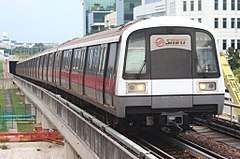 A C151 train operated by SMRT Trains. | |
| Public | |
| Industry | Public Transport Operator |
| Founded | Singapore (1987) (as Mass Rapid Transit Corporation) |
| Headquarters | City Hall, Singapore |
Area served | Singapore |
Key people |
Neo Kian Hong (President & group CEO) Seah Moon Ming (Chairman) Lee Ling Wee (CEO, trains) |
| Services | Railways |
| Parent | SMRT Corporation |
| Subsidiaries | SMRT Light Rail |
| Website | www.smrttrains.com.sg |
SMRT Trains Limited is a rail operator in Singapore and a wholly owned subsidiary of SMRT Corporation. After the privatisation of the MRT operations in 1995, it was originally named Singapore MRT Limited. In 31 December 2001, it was finally renamed to SMRT Trains Limited, so as not to confuse with another MRT line - North East MRT Line that is in another tender and the bus operations were merged from Trans-Island Bus Services. At the same time, Singapore Bus Services was renamed to SBS Transit to be multi-modal. SMRT Trains currently manages most of the MRT services in Singapore except the North East Line and Downtown Line.
SMRT Trains currently has one subsidiary, SMRT Light Rail, which owns the contract to operate the Bukit Panjang LRT Line.[1]
History
SMRT Trains Limited was incorporated as the rail subsidiary arm of the parent company SMRT Corporation, to oversee rail operations brought over from the previously state-owned Mass Rapid Transit Corporation (MRTC).
Mass Rapid Transit Corporation (MRTC)
The Singapore MRT Limited was incorporated on 6 August 1987, and signed the licence and operating agreement (LOA) with MRTC, a government-run corporation till 1997. On 7 November 1987, MRTC started services on Singapore's first MRT section, consisting of five stations from Yio Chu Kang to Toa Payoh. When the LTA takes over the MRTC, operations of the MRTC were hived off into SMRT Corporation. On 1998, the light rail operation was formed and was called Singapore LRT Limited. On 31 December 2001, both Singapore MRT Limited and Singapore LRT Limited were merged into the present name, SMRT Trains.
Transition to New Rail Financing Network
On 15 June 2016, SMRT Trains and its subsidiary SMRT Light Rail concluded discussions on the transition of the North-South and East-West Lines (NSEWL), the Circle Line (CCL) and the Bukit Panjang LRT (BPLRT) to the New Rail Financing Framework (NRFF). The framework, announced by the Government in 2008 under the Land Transport Master-plan, was introduced as an enhancement to the 1996 Rail Financing Framework, and was first implemented for the Downtown Line (DTL) in 2011.[2] SMRT transited to a 15-year contract under the new framework from Oct 1 2016, with the transfer of ownership of all its rail assets at a net value of $1.06 billion to the government. [3]
Fleet details
SMRT Trains Ltd. currently operates a fleet consisting of six rolling stocks builds on its two heavy rail lines (the North South Line and the East West Line) – namely C151, C651, C751B, C151A, C151B, C151C and CR151, identified by the relevant build contracts. In addition, it operates the C830, C830C rolling stocks, which serves the Circle Line. SMRT Trains Ltd. is also licensed to operate the CT251 stocks, which will be operate on the upcoming Thomson-East Coast Line from 2019. SMRT Light Rail operates the C801 and the C801A stocks on the Bukit Panjang LRT Line.
The main colour scheme for all the trains are black with red stripe, excluding C651 with the only exterior with white and red stripes, C801 with green and red stripes, C151B and C801A will bear the new SMRT livery, which consist of white, red, black and yellow pixel livery. The new LTA livery, which is black with green and red stripes, will be visible on C151C and R151 trains.
| Contract* | Image | Type | Maximum Speed (km/h) | Trains | Cars | Line(s) served | Built on | Introduction into service | Withdrawn from service | |
|---|---|---|---|---|---|---|---|---|---|---|
| Design | Service | |||||||||
| C151 |
 |
electric multiple unit | 90 | 80 | 66 | 396 | North South Line East West Line |
1986 – 1989 2006 – 2009 (Refurbishment) |
7 November 1987 | 2023 |
| C151A |
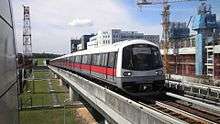 |
electric multiple unit | 90 | 80 | 35 | 210 | 2011 – 2014 | 27 May 2011 | N/A | |
| C151B |
_-_C151B_arriving_at_Tuas_Link_MRT_Station_(Kawasaki_Heavy_Industries_%26_CSR_Qingdao_Sifang_C151B_(KSF)).jpg) |
electric multiple unit | 90 | 80 | 45 | 270 | 2015 – 2017 | 16 April 2017 | N/A | |
| C151C |
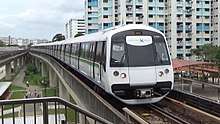 |
electric multiple unit | 90 | 80 | 12 | 72 | 2017 –2019 | 30 September 2018 | N/A | |
| CR151 |
electric multiple unit | 90 | 80 | 66 | 396 | 2019 onwards | 2022 onwards | N/A | ||
| C651
|
electric multiple unit | 90 | 80 | 19 | 114 | 1993 – 1994 2016 – 2018 (Refurbishment) |
2 May 1995 | N/A | ||
| C751B |
 |
electric multiple unit | 90 | 80 | 21 | 126 | 1999 – 2001 |
28 January 2000 | N/A | |
| C830 |
electric multiple unit | 90 | 78 | 40 | 120 | Circle Line | 2006 – 2008 | 28 May 2009 | N/A | |
| C830C |
electric multiple unit | 90 | 78 | 24 | 72 | 2014 – 2015 | 26 June 2015 | N/A | ||
| C801 | 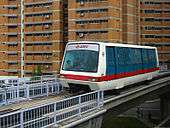 |
electric multiple unit | 55 | 48 | 19 | 19 | Bukit Panjang LRT | 1998 – 1999 | 6 November 1999 | N/A |
| C801A |
 |
electric multiple unit | 55 | 48 | 13 | 13 | 2014 – 2015 | 19 November 2014 | N/A | |
| CT251 |
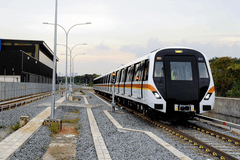 |
electric multiple unit | 90 | 80 | 91 | 364 | Thomson-East Coast Line | 2015 – 2020 | 2019 onwards | N/A |
Notable Incidents
- Before the start of service, a maintenance vehicle spilt oil on the tracks between Clementi and Jurong East. The first ten eastbound trains reported braking problems. Then, at 7.50 am on 5 August 1993, the eleventh east-bound train from Jurong stopped at the Clementi Station for two minutes longer than scheduled due to it using its emergency brakes to stop at the station, and was then hit by the twelfth east bound train when it failed to stop in time. 156 passengers were injured by the collision.[4]
- On December 15, 2011, train services were disrupted between Bishan and Marina Bay on the NSL. Two days after, train services were again disrupted between Toa Payoh and Marina Bay. This is the second worst major breakdown in SMRT history. SMRT suspected that the weight of the 4th generation trains, C151A, was the root cause of the breakdown. However, the 4th generation trains were sent back to China since July 2014. SMRT and LTA revealed that all of the critical parts like signalling, sleepers, third rail needs replacement by 2019.
- On March 9, 2015, the BPLRT came to a halt due to a station fire and a power fault, which resulted in a 24-hour service suspension. The cause of the power faults were due to the fire at Segar LRT Station. All trains were done system check while during the 24-hour service suspension, LTA and SMRT engineers went to inspect each stations and the tracks before testing if the line can reinstate service. Certain section of tracks deemed as "possible causes of power faults" ran on reduced speed until around the 4th week of July before reinstating normal speed.
- On July 7, 2015, the NSEWL was completely suspended from normal train services. It was also the first time both major lines were suspended simultaneously. This incident marks the worst breakdown in SMRT history. SMRT and LTA has suspected that faulty trains were the cause of this incident. Investigations concluded that a damaged insulator was the main cause of the multiple power trips on that day and SMRT could be fined for the lack of maintenance. Experts are looking into the matter to see if they can separate the power systems from the North South and East West Lines to prevent similar incidents form recurring.
- Pasir Ris rail accident: On 22 March 2016, 2 SMRT staff were killed when a train hit them near Pasir Ris station along the EWL. This is the first fatal accident SMRT ever had in history. Following an audit and investigation, the Ministry of Manpower (Singapore) reported that SMRT had failed to follow safety procedures to ensure worker safety for the past 14 years.[5] Former assistant engineer Lim Say Heng pleaded guilty to one charge of causing the deaths of the trainees by failing to observe critical safety protocol and was sentenced to four weeks jail.[6]
- On 7 October 2017, train services along the North South Line between Ang Mo Kio and Marina South Pier were disrupted due to flooding of MRT tunnels caused by a pump failure during rain.[7] Train services between Newton and Ang Mo Kio remained unavailable for 21 hours till the afternoon of the following day.[8][9] In the aftermath of the flooding incident, Ng Teck Poo, vice-president of maintenance and systems at SMRT was replaced.[10] Following further investigations, the manager and staff responsible for the maintenance of the pumps were suspended after it was revealed that maintenance for the past three quarterly maintenance (starting from December 2016) may have been falsified.[11]
- Joo Koon rail accident: On November 15, two C151A trains collided at Joo Koon, injuring 28 people, making the second incident after 24 years on 5 August 1993 when two C151 trains collided at Clementi.
The trains are classified as contracts unlike other countries which uses "class".*
References
- ↑ "About SMRT: Business and Subsidiaries". Retrieved November 4, 2017.
- ↑ "SMRT Trains and SMRT Light Rail to Transit to New Rail Financing Framework | Press Room | Land Transport Authority". www.lta.gov.sg. Retrieved 2018-07-29.
- ↑ hermesauto (2016-07-15). "LTA to buy $1b of SMRT assets under new rail financing framework". The Straits Times. Retrieved 2018-07-29.
- ↑ http://eresources.nlb.gov.sg/INFOPEDIA/articles/SIP_814_2004-12-31.html
- ↑ http://www.todayonline.com/singapore/smrt-did-not-comply-safety-procedures-staff-track-access-14-years-mom
- ↑ https://sg.yahoo.com/news/ex-smrt-engineer-jailed-4-weeks-accident-caused-death-two-trainees-082028778.html
- ↑ "Timeline of NSL disruption due to flooded MRT tunnel". Channel NewsAsia. 8 October 2017.
- ↑ "NSL disruption: Malfunctioning water pumping system resulted in flooded MRT tunnel, says LTA". Channel NewsAsia. 8 October 2017.
- ↑ http://redwiretimes.com/singapore-in-brief/21-hour-train-disruption-due-to-flooding-another-warning-sign-of-mrt-system-management-lapses/
- ↑ https://www.theonlinecitizen.com/2017/10/12/smrt-maintenance-vice-president-replaced-news-source-reports-inadequate-maintenance-of-water-pumping-system-behind-tunnel-flooding/
- ↑ http://www.todayonline.com/singapore/full-smrt-and-ltas-statements-suspected-falsification-maintenance-records-bishan-station
.jpg)